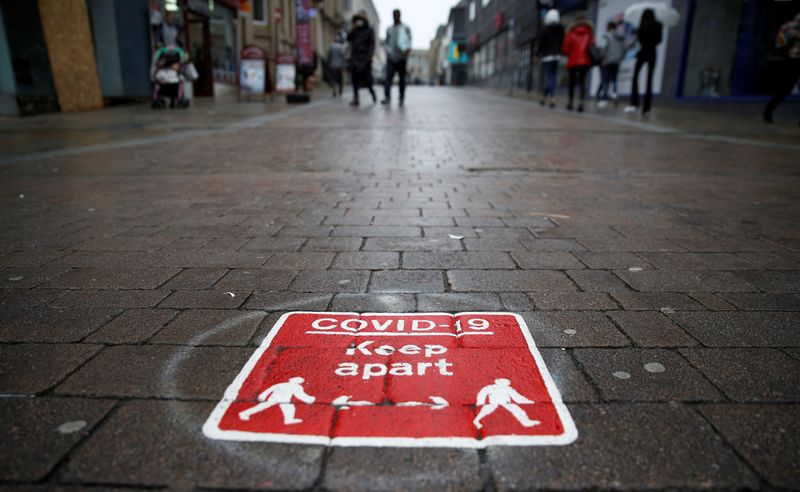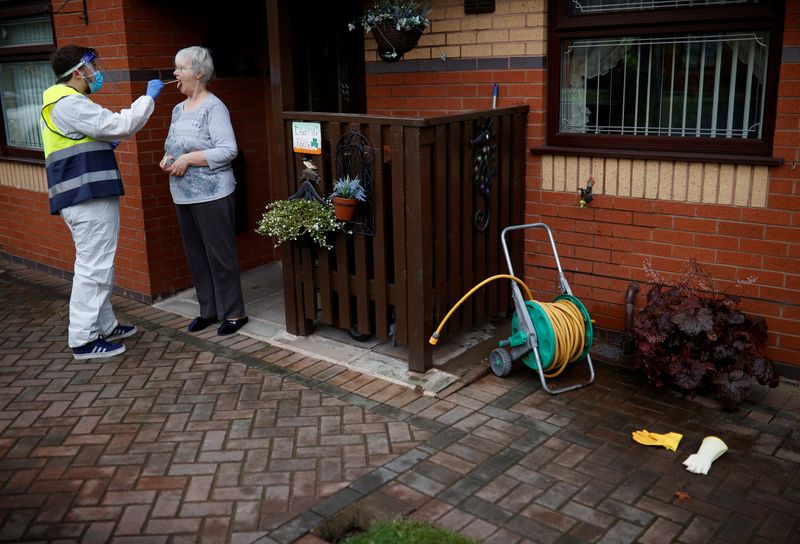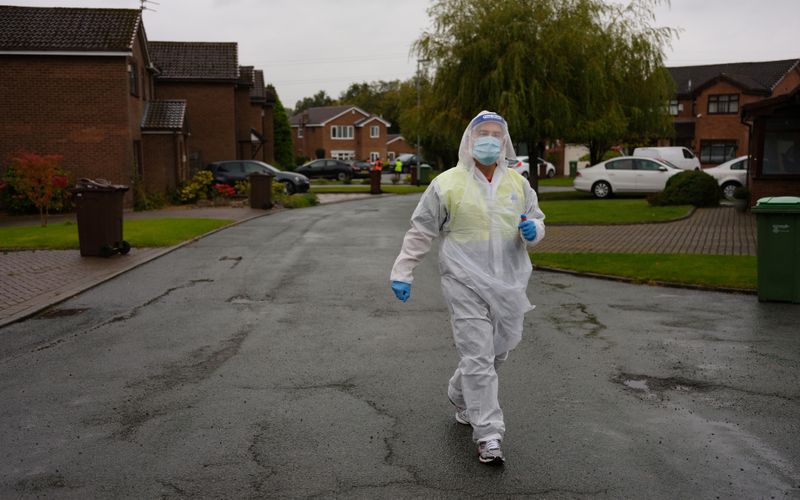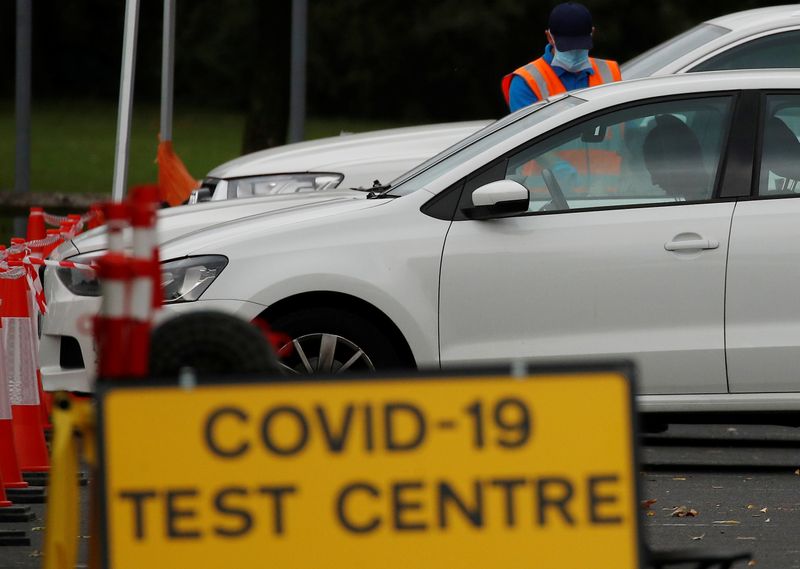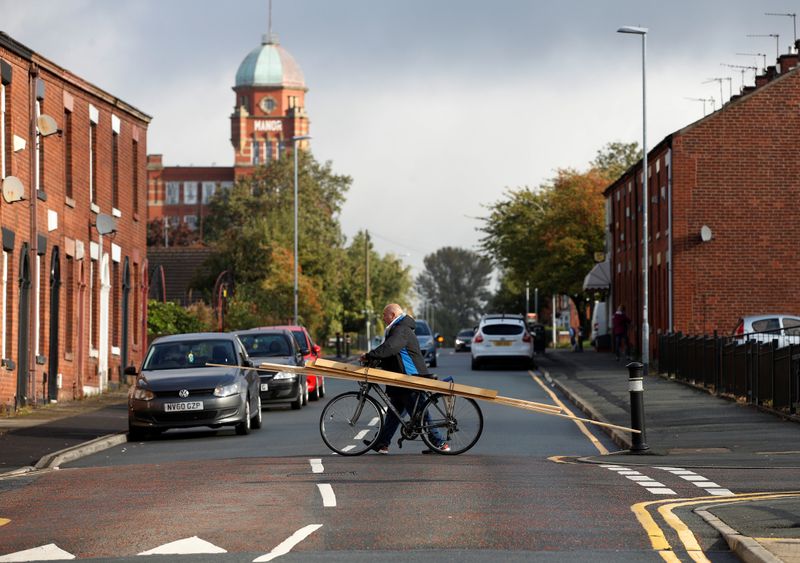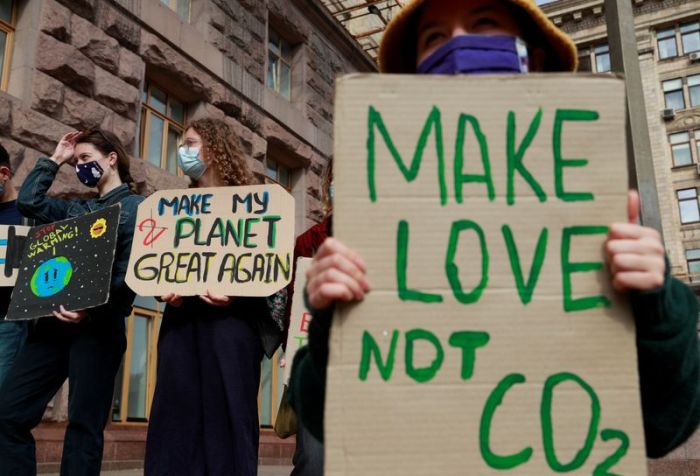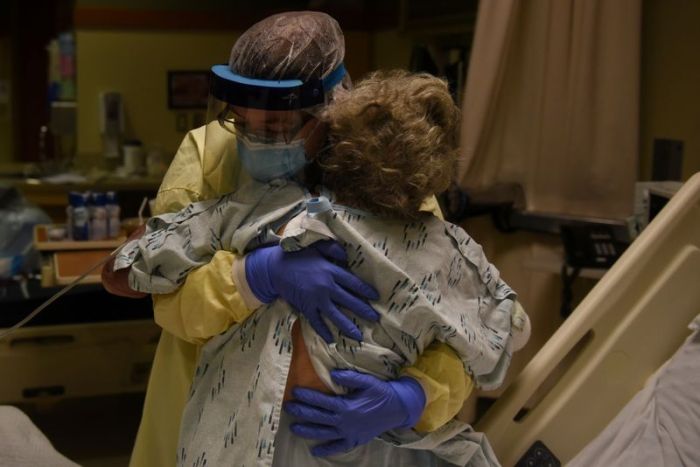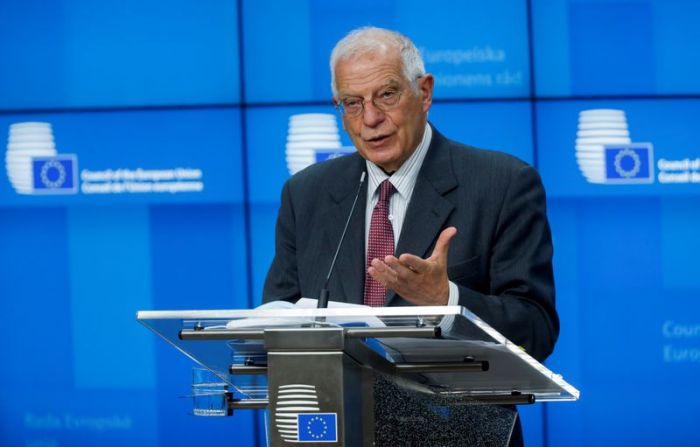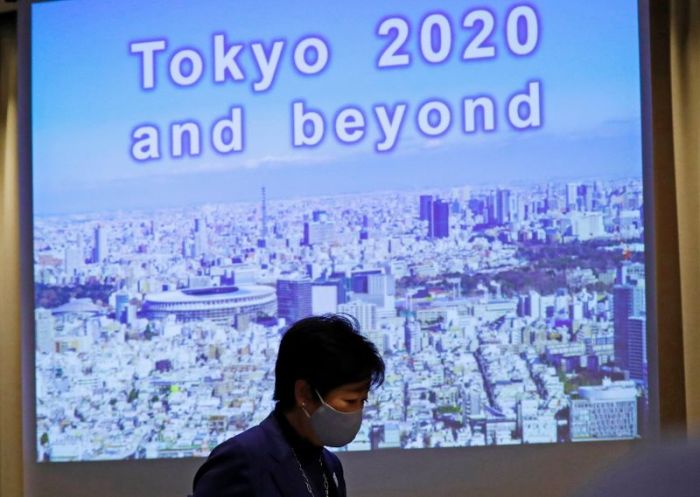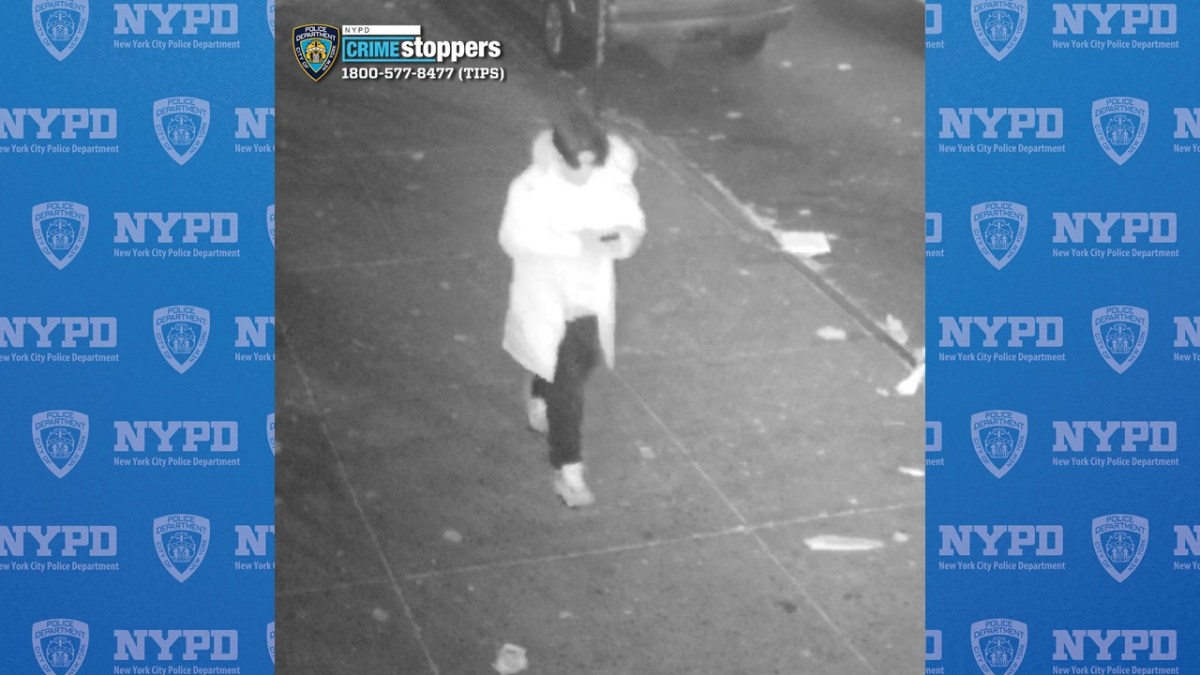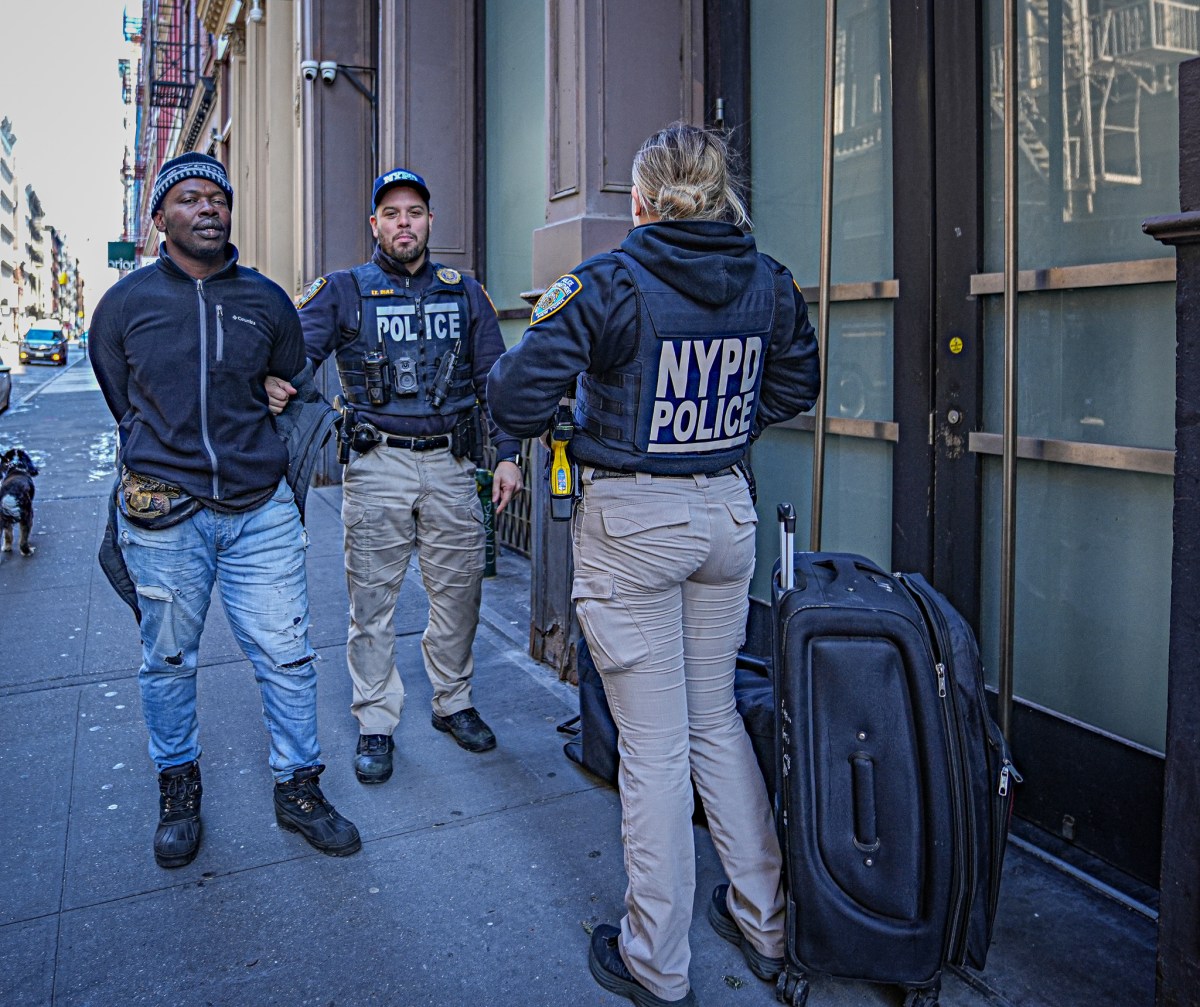HALIFAX, England, Nov 24 (Reuters) – By Andrew MacAskill, Stephen Grey, Ryan McNeill, Steve Stecklow, Tommy Wilkes and Andrew R.C. Marshall
On the doorstep of a terraced house in northern England, virus hunter Colin Hutchinson came face-to-face with the new wave of COVID-19, and the obstacles to slowing its spread.
A retired surgeon, Hutchinson is part of a local team of “contact tracers” in Halifax, Yorkshire, that aims to reach infected people before they infect others. His experience that day in mid-October, he said, summed up why Britain’s “tracking of the virus is very, very poor.”
He wanted to speak urgently to a 54-year-old woman who’d tested positive for COVID-19, to identify her contacts. The area’s two hospitals were filling up – 40 COVID-19 patients were already being treated – and deaths from the virus had tripled in the district in the previous two weeks.
A gaunt woman appeared at the door, coughing. She apologised for not answering her phone, then gave Hutchinson the details of six others who were ill. Then came the bureaucracy. The six, all a few feet away inside the house, must be told to isolate. But, under the rules of England’s Test and Trace system, Hutchinson wasn’t allowed to speak to them. Instead, he had to go home and enter their names into a database so a call centre could contact them individually.
“The whole process could have been wrapped up there in one go,” said Hutchinson, a local councillor for the opposition Labour Party.
The government says the rules are designed to ensure patient confidentiality. For many health experts, such incidents exemplify a systemic failure to control COVID-19.
Among the world’s wealthiest nations, Britain had the second-highest death toll from the coronavirus in the first wave of the pandemic, behind the United States. Adjusted for population, Britain’s toll was the third highest.
After enduring a three-month lockdown in the spring, Britons hoped that Prime Minister Boris Johnson’s government would put in place a new strategy to protect the nation through the winter. But with infections again spreading and deaths reaching over 350 per day, England entered another lockdown on Nov. 5.
The country is one of many struggling to cope with a new surge of the disease. With more than 12,000 additional deaths by Nov. 19 in the second wave, Britain is recording nearly four times more deaths per capita than Germany, though not as many as Spain or France. Few countries have got things completely right.
Johnson, who contracted the coronavirus himself, was blamed by many scientists for acting too slowly to stop the initial spread in the spring. As Reuters reported earlier this year, behind this tragedy lay a failure to spot the infection as it arrived, to stamp it out with an early lockdown and to implement effective tracing and isolation of cases, as pioneered in Asia and used to effect in Germany.
Stung by such criticism, Johnson offered hope. Even if cases rose again, he said confidently on June 3, the country would be able to “replace national lockdowns with individual isolation and, if necessary, local action where there are outbreaks.” A month later, he told lawmakers a system now in place to test and trace COVID-19 cases was “as good as, or better than, any other system anywhere in the world” and would play “a vital part in ensuring that we do not have a second spike this winter.”
Now, an investigation by Reuters has exposed how lessons from the first wave were not learned, and why Britain once again was forced into a drastic lockdown. New measures were put in place – a rapid increase in testing capacity, for example. But the government’s failure to share full data on the disease’s spread with local authorities and the public gave a false impression of success. This concealed what one health expert called an “iceberg” of infection and led to a relaxation of social restrictions too soon in some places.
And while tests and contact tracing expanded, they did so in such an inefficient way that they couldn’t keep pace with the spread of the virus. A Reuters analysis reveals that England has managed to trace just one non-household contact – someone who doesn’t live with the infected person – for every two identified cases of COVID-19. That compares to over 20 contacts for each single case in Singapore and Taiwan, according to studies.
The reason for this dysfunction, Reuters reporting shows, lies in a disjointed design and a government preference, contrary to some expert advice, for national solutions over targeted, local responses.
“This is not the system that I would design from what I understand about it now,” said David Heymann, a world authority on contact tracing and the first chairman of Public Health England, the government agency charged with leading the response to pandemics. A system to tackle the pandemic needs to be locally centred, said Heymann. “Face-to face trust is what’s important…You can’t do contact tracing from a central location to be effective.”
A spokesman for the Department of Health and Social Care, Britain’s health ministry, denied that the government’s response to COVID-19 was failing. Since the start of the pandemic, the spokesman said, “we have worked rapidly to build the biggest testing system per head of population of all the major countries in Europe.” The tracing system was helping to stop the spread of the virus and had asked more than two million people to self-isolate, the spokesman added.
A LOST OPPORTUNITY
At the start of the summer, as the first wave of COVID-19 retreated, scientists told the government what was now required: a system to suppress any new outbreaks quickly. At its centre, scientists said, should be contact tracing: detective work to locate outbreaks and find and quarantine any potential new cases.
Asia-Pacific countries such as China, South Korea, Singapore, Australia and New Zealand had shown how rapid, local and intrusive steps can be effective in extinguishing outbreaks. But such work is intensive. It needs to happen at lightning speed and people need to isolate when told to do so.
The government’s scientific advisory committee, SAGE, backed by multiple research reports, told Johnson in May that after a person got sick with COVID-19, an effective system requires 80% of their contacts to be reached and told to isolate within three days.
That is difficult, and the scientists emphasised the need for other measures as well. Graham Medley, a member of SAGE, told Reuters contact tracing can never replace measures such as social distancing. Both are necessary.
Johnson was under political pressure from within his own party to ease restrictions that were damaging the economy and limiting people’s freedoms. By May 20, he announced the creation of a “world-beating” contact-tracing service to reopen the country.
A business executive and Conservative Party member of the House of Lords, Dido Harding, took charge of the new system. It aspired to what she called on June 11 the “gold standard” of “isolating all contacts within 48 hours of someone requesting a test.” Scientists made clear that anything less would be ineffective in stopping the spread of the virus.
A Reuters study of official data shows that, as things turned out, Harding’s system fell far short of this target. At best, about half of all contacts of people sick with COVID-19 are told to self-isolate. And it takes tracers an average of six or seven days from when someone gets sick to reach those contacts. Reuters also found that many people withhold the names of their contacts, and there is usually no detailed follow-up investigation.
Some scientists said the problem was that the government made a system of ill-fitting parts. There was a testing system, a separate national tracing service and a smartphone app for digital contact tracing.
“It’s like we’ve got three-quarters of a dam,” said David Bonsall, a clinical scientist at Oxford who has advised the government on its smartphone app. “I’m very proud of what we’ve built, but three-quarters of a dam is as good as no dam at all.”
The system’s gaps are deadly. “What you’ve got are giant holes representing parts of Track and Trace that are too slow to stop a wave of infections. And it’s like natural selection – the virus just works its way through those holes,” Bonsall said.
Eleanor Roaf, a public health director in Trafford, which covers part of the Greater Manchester region, said delivering a good test-and-trace system on time had been one of the “lost opportunities in lockdown.”
A health ministry spokesman said the government had always said that test and trace was “not a silver bullet.”
LAYERS UPON LAYERS
As they looked around for an institution to run a contact-tracing system, Johnson and Harding did have one available: the country’s National Health Service (NHS) which provides free healthcare to all.
In normal times, medical tests are carried out by general practitioners or in NHS hospitals; analysis is done in NHS labs or labs belonging to government agency Public Health England. NHS doctors and nurses who handle infectious disease have experience in contact tracing, as do local and regional health teams.
But instead, the government created a 12 billion pound ($16 billion) Test and Trace system that is largely privately operated. Three firms – Randox Laboratories, Serco Group Plc and Sitel Group – got among the biggest contracts, more than 725 million pounds between them, much of it without other companies being invited to bid. Private companies would handle the bulk of COVID-19 tests and, separately, contact tracing.
Health Secretary Matt Hancock explained at the time that Britain was turning to commercial and academic partners to “build from scratch.” On April 2, John Newton, the official then leading the testing program, announced the creation of a “separate workstream entirely independent of the NHS.”
While it’s unclear how an NHS-run system would have coped with building up testing and tracing, the chosen design went against the advice of some scientists and public health experts. Local directors of public health, who are employed by local authorities, had been lobbying the government to be involved. On May 18, the Association of Public Health Directors complained about “the limited extent that the government has involved local government in all aspects of the test, track and trace programme.”
The first part of the new service was testing. Hancock laid out its importance on May 21, saying, “As we follow our plan, our testing regime will be our guiding star. It’s the information that helps us to search out and defeat the virus.”
The government outsourced the organisation of non-hospital tests, referred to as community tests, to consultancy firm Deloitte. It created an online booking service and a network of drive-through testing centers. A chain of privately-run laboratories, known as Lighthouse Labs, was established to analyse the samples. These labs were operated by various firms and academic institutions, and overseen by the Department of Health, the health ministry.
In a statement to Reuters, the ministry denied bypassing the NHS. A spokesman said existing NHS labs had greatly expanded operations but new mass capacity was required.
The contact-tracing part of the new Test and Trace service was launched at the end of May. Serco and Sitel recruited thousands of “tracers” whose job it is to call people and tell them to isolate.
And there was one more element. The government announced in April what officials called a game changer – a smartphone app that would do some of the work of human contact tracers. But the original app was scrapped in June before its launch because of technical problems. Months were spent developing a new one, which was finally released in September.
Between all these components of Test and Trace is a series of computer systems through which the details of people with COVID-19 and their contacts are passed. Reuters found that to get a non-hospital test result, details of a patient’s case flow through at least four different databases. To reach a contact tracer, the case flows through at least five.
This complexity created delays. Mat Barrow is the managing director of a private Leeds-based company, X-Lab, that runs a national exchange that processes test results. Barrow told Reuters that sending results directly to local authorities rather than through the various databases would shorten the current process by “about a day.” Experts say this could make a critical difference in blocking the disease’s spread.
The data transfer led to glitches. In September, nearly 16,000 positive case records were lost from the system for several days – causing a delay in contact tracing. The government blamed a “legacy” file system that cut off records after about 65,000 rows of data. Hancock, the health minister, said the incident “should never have happened.”
Jon Crowcroft, professor of communications systems at the University of Cambridge, said the more databases used, the greater the chance of things going wrong, and centralising data can lead to errors and delays. There are cloud-based platforms that can handle much bigger datasets more quickly and reliably, Crowcroft said. “The data in this case is not complex. I’m mystified why they’d not start from something slightly more up-to-date.”
The government disputes that it created a disjointed system. The health ministry spokesman told Reuters – without providing evidence – that the test-and-trace service was “breaking chains of transmission” thanks to cooperation between local and national teams in “the largest diagnostic network in British history.”
A HIDDEN ICEBERG
In the first wave of the pandemic, Britain’s testing capacity was well below what was needed. As Reuters has previously reported, at first more than 99 in every 100 cases went undetected. Heading into the summer, Johnson hoped the new Lighthouse Labs would make a difference. He set a target of 500,000 tests per day capacity by the end of October, up from 25,000 in mid-April.
Even as testing was increasing, many local authorities were struggling to get access to the results of the community tests, leaving them in the dark about how many cases there were in their area. This was because, until the end of June, there wasn’t a system to transfer results from the Lighthouse Labs to local health officials.
When the information was finally shared, it revealed what Roaf, the Trafford public health director, said was an “iceberg” of hidden infections in northwest England, particularly in less affluent areas. In Greater Manchester, for instance, when the Lighthouse Lab data for June was added to the previously available figures, it pushed up the number of cases to nearly 2,500 from 703.
In the town of Oldham in Greater Manchester, results from hospital tests had suggested the number of cases was falling in June. When the community testing data became available, a more worrying picture emerged, said Arooj Shah, deputy leader of Oldham Council. The infection rate had not budged at all and remained “significantly higher” than England’s overall average. The new adjusted figures for Oldham showed 391 cases, a five-fold increase.
Many officials in the North believe that, if they’d had full access to the data, they would have argued against easing social restrictions from July. “The lockdown probably finished about the right time in London, but that was too soon for us,” said Roaf. “The view in the North West is that we didn’t push it down low enough before everything unlocked.”
There was a harsh human cost. While Johnson permitted holiday travel from July and launched a discount scheme to revive pubs and restaurants, many elderly and other vulnerable people were kept in isolation through the summer months. As case numbers rose again, hopes of family reunions slipped away.
Before the pandemic, Marie Meehan used to visit her 91-year-old mother, Peggy Curley, twice a day in her Liverpool nursing home, stopping in before and after work.
When Britain entered its first lockdown in the spring, Meehan and other families would gather at the windows to see their parents. “My mum would actually walk the length of the room to wave back at me. She was expecting me,” Meehan said.
There were video chats, and one brief visit in an outdoor gazebo. But, as COVID-19 cases started rising again, Meehan despaired. She joined tens of thousands of people in signing a petition from a grassroots group called Rights for Residents that pleaded with the government to ease restrictions on nursing home visits. Hancock, the health minister, has said he hopes to allow family visits to care homes in England by Christmas.
FAILING THE TEST
After spreading in the North, cases grew steadily across the country – compounded by the reopening of schools at the start of September. COVID-19 was back. Johnson and his ministers had long predicted a second wave in the winter. But not this soon.
And Britain still lacked the infrastructure to deal with it. Testing couldn’t keep pace. The new Lighthouse Labs built up capacity quickly to the end of June, but in July growth slowed and then total capacity began to fall. By Aug. 30, overall testing capacity across all labs stood below the July 9 level.
The reason was a shortage of staff, four laboratory workers told Reuters. The Lighthouse Labs had drawn in temporary staff from universities when they first launched, but as summer ended many of these people returned to their regular jobs. A supervisor at a lab in Milton Keynes, in southern England, said his shift team fell from about 50 in June to below 40 on some days in late summer.
The spokesman for the health ministry, which oversees the Lighthouse network, said the labs had “successfully transitioned” from using highly skilled volunteers to more permanent staff.
By September, demand for tests outstripped the Lighthouse Labs’ capacity, creating a backlog. Thousands of tests were sent abroad for processing and access to tests was delayed.
Back in the first wave, the government’s scientific advisory committee, SAGE, had blamed a “lag in data provision for modelling” for the failure to track the pandemic’s swift spread in Britain. Over the summer, the lag in recording cases didn’t improve.
A Reuters analysis found that it typically took two days to get tested after developing symptoms and a further three days for the result of that test to make it to local officials and contact tracers. That made it impossible to hit the government’s target of isolating all contacts of an infected person within 48 hours of symptoms appearing.
Many results took far longer – about 91,000 took four days, and nearly 70,000 took five days or more.
THE TRACERS
The contact-tracing system, too, has been beset by problems.
Polly Gould, who runs a travel agency on the Isle of Wight, said her family was bombarded with more than 60 phone calls, emails and text messages in October after her two daughters tested positive.
The Gould sisters, who’d come home to celebrate their mother’s birthday, each received a 20-minute call from a contact tracer to ask who they live with and where they had been recently. They were told to self-isolate. Each family member the sisters named as a contact then received a call seeking the same information. That in turn triggered another round of calls to the family, and another.
“It has absolutely driven me mad,” said Gould.
While Gould’s family was deluged with calls, Tim Daily, a 57-year-old financial adviser in Milton Keynes, got none. On Sept. 23, three days after being tested, Daily woke to a text message and email telling him he was positive and should self-isolate for 10 days. “Straight away I was thinking, ‘I should be getting a call from Test and Trace at any time,'” said Daily, who regularly meets four or five clients a day. When the call didn’t arrive, Daily contacted his clients himself. He told Reuters that no contact tracer has ever called him.
The contact-tracing system involves a network of newly recruited staff, most of them working from home. About 3,000 of these are doctors and nurses, often retired. Their job is to call people who’ve tested positive and make a list of recent contacts.
A second group then takes over to call the contacts. Serco and Sitel employ about 12,000 people to do this.
Reuters interviewed seven current and former tracers. Several explained how frustrating they found an automated system that dictates who they call and insists they work from a script. The system requires different members of the same household to be called separately, often on the same number.
Hancock said on Nov. 23 that members of the same household would no longer be called individually by contact tracers.
Most of the time, the contact tracers said they had little to do – even when COVID-19 cases were rising.
Two tracers, both retired doctors, said they didn’t make any calls. One explained how he struggled to log on to the various systems, about six of them, each requiring a username and password. Another said there was a month-long delay in sending him his login details.
A student, working for Sitel from home, told Reuters she had so much free time that she had sewn up all her housemates’ moth-eaten clothes and learned to knit. Another student, working for Serco, said he makes about six calls a day from his bedroom in a shared flat. Some days he doesn’t speak to anyone because the contacts don’t answer the phone. He said many people don’t answer because the tracers call from an unrecognised number, which looks like it’s coming from a marketing company.
Each tracer has on average reached less than one contact per day since the end of May, including household members, according to a Reuters analysis of official data.
A spokesperson for Serco said stories about call handlers with little to do were “an out-of-date depiction” and the service is now a lot busier. “Our operational delivery has been outstanding,” the spokesperson said.
Sitel referred questions about the system’s performance to the health ministry, which oversees and manages it.
The ministry spokesman stressed that contact tracers were reaching “the vast majority of people testing positive and their contacts.” He pointed to data published Oct. 2 showing that in the most recent week the service reached 71.3% of people who tested positive and 83.7% of contacts, where their details were provided.
A Reuters analysis of official data found such figures don’t tell the full story. Only two thirds of people who test positive are reached and willing to provide details of their contacts, the data show. So, on average, no more than 54% of contacts are traced. This figure includes people in the same household, who should be isolating anyway, under government rules. In summary, Reuters found that only half of a non-household contact – someone not living with the infected person – was tracked down in each of the 604,000 COVID-19 cases handled by national tracers since May 28.
Local officials described being sent lists of infected people who claimed to have been in touch with no one. There was no contact information for nearly one in four contacts in the week to Nov. 4, official data show. That compares with 31 contacts per case in Singapore and 27 in Taiwan, according to studies of their methods.
The system is not only inefficient, it’s also slow, according to tracers and Reuters’ data analysis. This analysis shows that from the onset of symptoms, it typically takes seven days in England to reach an infected person’s contacts.
“If you are taking that long, you really have to ask, what is the point?” said Martin McKee, a professor of public health at the London School of Hygiene & Tropical Medicine.
In contrast, Singapore’s health ministry said in September it had cut the average time taken to identify and quarantine close contacts to under two days.
The system continues to creak. In the week to Nov. 11, the latest available data, only six out of 10 of the total number of contacts identified by people who tested positive, including household contacts, were reached and asked to self-isolate. The number has barely changed since June.
Many epidemiologists told the government from the beginning that a very different approach was necessary to have any hope of preventing a second wave – to build a system to trace the disease at the grassroots level.
In May, Britain’s leading scientific body, the Royal Society, had stressed the need for “local integration of systems.”
The government was slow to take up that message. With few extra resources, local authorities could create only small teams of contact tracers. These local teams only take on cases that the national team has already failed to deal with – leading to more delay. A report by one London authority found the average time between a positive test and the case reaching local teams was 5.7 days.
The health ministry spokesman said testing and tracing “has always been a collaboration” with local authorities.
As the pandemic worsened, cases in Liverpool skyrocketed. Restrictions at the city’s nursing homes became ever tighter, including at the residence where Meehan’s mother, Peggy Curley, lived.
Dreaded news reached Meehan in October. Several of the residents had tested positive for COVID-19. Soon afterwards, her mother developed a fever and a slight cough. She, too, tested positive.
As her 91-year-old mother’s health declined, Meehan finally was allowed to visit. “No one wants to get ‘the call’ to go in and see our loved ones when it is obviously too late, when all we wanted was to spend any quality time whilst they were well enough to see us,” Meehan said.
On Nov. 9, two weeks after testing positive for COVID-19, Meehan’s mother died.
(reporting by Andrew MacAskill, Stephen Grey, Ryan McNeill, Steve Stecklow, Tommy Wilkes and Andrew R.C. Marshall; editing by Janet McBride)

